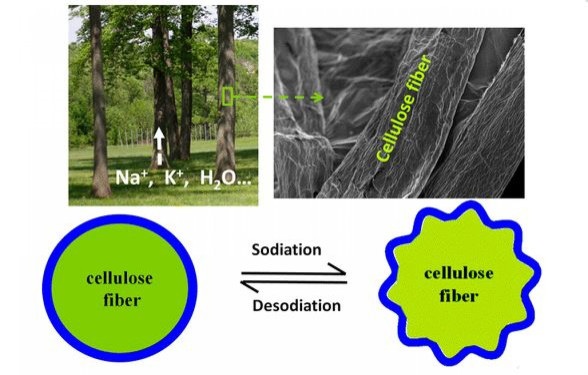New Eco-Friendly Battery Made of Wood And Sodium Can Be Charged More Than 400 Times
Using only wood, tin and sodium as raw material, scientists at the University of Maryland have come up with a tiny, long-lasting, eco-friendly battery that can be charged hundreds of times.
The scientists built the battery by using a very thin piece of wood, which they say is “a thousand times thinner than a piece of paper,” coated with tin. And, instead of lithium, which is found in many rechargeable batteries, they chose to use sodium to make it eco-friendly.

According to the scientists, lithium can be more efficient than sodium in storing energy. But sodium, wood and tin are more readily available, making them the ideal materials to build a cheap battery that can stock huge amounts of energy, not unlike solar energy at a power plant.
“Sodium [Na]-ion batteries offer an attractive option for low-cost grid scale storage due to the abundance of Na. Tin (Sn) is touted as a high-capacity anode for Na-ion batteries with a high theoretical capacity of 847 mAh/g,” scientists said in a research paper that appeared in ACS Publications.
The ubiquitous lithium-ion batteries are generally inflexible, making them fragile and susceptible to swelling and shrinking. But the new sodium-ion battery is capable of withstanding extreme conditions, the scientists say, thanks to the wood fibers that are supple enough to let it survive more than 400 charging cycles, putting the new battery in the company of the longest-lasting nanobatteries.
“The soft nature of wood fibers effectively releases the mechanical stresses associated with the sodiation process, and the mesoporous structure functions as an electrolyte reservoir that allows for ion transport through the outer and inner surface of the fiber,” scientists said.
Liangbing Hu, an assistant professor of materials science at the University of Maryland, said that the idea of a wood-sodium battery was inspired by trees. According to him, wood fibers from trees are capable of storing mineral-rich water and so are ideal for storing liquid electrolytes, making them not only good as the base but also an active part of the battery.
Scientists observed that after charging and discharging the battery hundreds of times, the wood used in it got wrinkled but remained intact and the wrinkles helped reduce stress on the battery during the process.
"Pushing sodium ions through tin anodes often weakens the tin’s connection to its base material,” said Teng Li, an associate professor of mechanical engineering. "But the wood fibers are soft enough to serve as a mechanical buffer, and thus can accommodate tin’s changes. This is the key to our long-lasting sodium-ion batteries."
According to the new research, which was funded by the University of Maryland and the National Science Foundation, the soft and mesoporous wood-fiber substrate can be utilized as a new platform for low-cost, sodium-ion batteries.
This is not the first time scientists have developed small batteries that can store huge amounts of power.
In April, scientists at the University of Illinois at Urbana-Champaign developed new microbatteries, which they claimed could “pack such a punch that a driver could use a cellphone powered by these batteries to jump-start a dead car battery -- and then recharge the phone in the blink of an eye.”
© Copyright IBTimes 2024. All rights reserved.






















